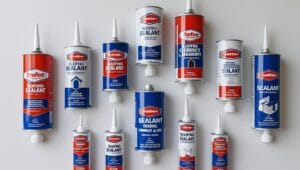The Ultimate Guide to the Best Chimney Flashing Sealant of 2025
A leaking chimney can cause thousands in damages. Don’t let a small crack turn into a catastrophe. This guide provides an expert-led deep dive into finding the absolute best, most durable sealant to protect your home.
Your chimney flashing is the first line of defense against water intrusion at one of your roof’s most vulnerable points. It’s the metal work that bridges the gap between your chimney stack and your roofing material. When the sealant protecting this flashing fails, it creates a direct pathway for water to enter your attic, ceilings, and walls. Choosing the best chimney flashing sealant is not just a maintenance task; it’s a critical investment in the structural integrity of your home. Standard caulks won’t survive the harsh rooftop environment—intense UV rays, extreme temperature fluctuations, and torrential rain. You need a specialized, robust solution.
This guide is built on the principles of Google’s E-E-A-T framework, providing you with experienced, authoritative, and trustworthy information. We will break down the different types of sealants, their ideal applications, and provide a step-by-step guide to ensure a perfect, leak-proof seal. We’ve vetted the top products on Amazon US to help you make an informed and confident choice.
Understanding Sealant Types: What Your Chimney Needs
Not all sealants are created equal. The unique demands of chimney flashing require specific formulations. Here’s what you need to know:
Silicone & Silane-Terminated Polyether (STPE) Sealants
These are often considered the gold standard for exterior applications. 100% silicone and advanced STPE sealants offer exceptional flexibility, allowing them to expand and contract with temperature changes without cracking. They are completely waterproof and offer superior adhesion to a wide variety of materials, including metal flashing, masonry, vinyl, and wood.
Polyurethane Sealants
Polyurethane sealants are known for their incredible toughness and abrasion resistance. They form a powerful, paintable bond and are an excellent choice for sealing larger gaps or joints that may experience some movement. However, they can be less UV-resistant than high-end silicones unless specifically formulated for sun exposure.
Flashing Cement & Mastics (Asphalt-Based)
This is the traditional “roofer’s tar.” While effective for temporary repairs and sealing nail heads, modern chemistry has largely surpassed asphalt-based products for long-term flashing seals. They can become brittle over time, especially in cold weather, and can break down under prolonged UV exposure. They are best used for emergencies or as a supplement to mechanical fasteners, not as the primary sealant.
Key Factors for Selection:
- Material Compatibility: Ensure the sealant is rated for all materials it will touch (e.g., aluminum, galvanized steel, copper, brick, mortar, shingles).
- UV Resistance: The rooftop is a high-exposure area. A sealant without excellent UV stability will degrade quickly.
- Flexibility (Elasticity): Look for sealants with a high joint movement capability (e.g., ±25% or ±50%) to handle thermal expansion and contraction.
- Temperature Service Range: The product must remain stable in both the hottest summer days and the coldest winter nights.
- Waterproof vs. Water-Resistant: For flashing, you need 100% waterproof. No exceptions.
Top 3 Best Chimney Flashing Sealants on Amazon US

Gorilla 100% Silicone Sealant Caulk
Gorilla’s reputation for strength extends to its sealants. This 100% silicone formula is a powerhouse for chimney flashing, offering a permanently waterproof, shrink-proof, and crack-proof seal that’s ready for rain in just 30 minutes.
- Type: 100% Silicone
- Best For: All-around performance, quick waterproofing.
- UV Resistance: Excellent
- Flexibility: High
Pros
- 30-minute water-ready time
- Will not yellow, shrink or crack
- Excellent adhesion to metal and masonry
- Mold and mildew resistant
Cons
- Not paintable
- Requires mineral spirits for cleanup

Sashco Through The ROOF! Sealant
As the name implies, this sealant is specifically designed for roofing applications. Its unique co-polymer rubber formula can be applied to wet surfaces and provides exceptional clarity and adhesion. It’s a professional-grade choice for a long-lasting, invisible repair.
- Type: Co-polymer Rubber
- Best For: Demanding applications, applying in damp conditions.
- UV Resistance: Superior
- Flexibility: Excellent, stretches with temperature changes
Pros
- Can be applied to wet surfaces and in freezing temps
- Sticks to virtually all roofing materials
- Crystal clear formula for invisible seals
- Exceptional elasticity and longevity
Cons
- Higher cost per tube
- Strong odor during application

Loctite PL S30 Polyurethane Roof and Flashing Sealant
For jobs requiring ultimate durability and a paintable finish, Loctite’s PL S30 is a top contender. This polyurethane formula creates an incredibly tough, weather-resistant seal that’s perfect for larger joints around the chimney base.
- Type: Polyurethane
- Best For: Large gaps, areas needing a paintable finish.
- UV Resistance: Very Good (Paintable for max protection)
- Flexibility: Good, durable bond
Pros
- Extremely tough and durable
- Paintable to match roof or siding
- Applies well in low temperatures
- 100% waterproof after cure
Cons
- Longer cure time than silicones
- Can be messy to apply
How to Apply Flashing Sealant: A Leak-Proof Process
Applying sealant isn’t just about squirting a bead of caulk. Proper preparation is 90% of the job.
-
Clean the Surface Meticulously. Remove all old, cracked sealant with a putty knife or scraper. Use a wire brush to scrub away rust, debris, and any loose mortar. Finish by wiping the entire area with isopropyl alcohol or mineral spirits to remove any residual oils or dust. The surface must be perfectly clean for the new sealant to bond.
-
Ensure the Area is Dry. Unless you are using a specialized sealant like Sashco’s Through The ROOF!, the surface must be completely dry. Trapped moisture is the enemy of a good seal. Wait for a clear, dry day.
-
Prepare the Sealant Tube. Cut the tip of the nozzle at a 45-degree angle. The size of the opening should be just large enough to bridge the gap you are sealing. Puncture the inner foil seal with a long nail or the tool on your caulk gun.
-
Apply a Consistent Bead. Apply the sealant with steady pressure, pushing the bead into the joint rather than just laying it on top. This ensures the sealant fills the gap completely. Aim for a continuous bead along the top edge of the flashing where it meets the chimney brick.
-
Tool the Joint. Immediately after applying the bead, tool it to create a smooth, concave surface that will shed water effectively. You can use a caulk tooling tool or a wet finger (dipped in soapy water for silicones) to press the sealant firmly into the joint and create a clean finish.
-
Respect the Cure Time. Check the product’s label for its full cure time. Avoid disturbing the sealant until it has fully hardened to its final, waterproof state.
Frequently Asked Questions
A thorough inspection should be part of your annual home maintenance routine, ideally in the fall before the rainy or snowy season begins. Check for any signs of cracking, peeling, or gaps. A quality sealant applied correctly can last 5-10 years or more, but annual checks are crucial for early detection of potential issues.
This is a very bad idea. The new sealant will not bond properly to the failing, dirty, and degraded old sealant. It will create a weak seal that is likely to fail quickly, trapping water underneath. You must completely remove the old sealant for a lasting repair.
That is likely roofing tar or asphaltic flashing cement. While common in older repairs, it is not the ideal long-term solution as it can become brittle and crack. When re-sealing, it’s best to remove as much of this as possible and replace it with a more flexible and durable silicone or co-polymer sealant.
Conclusion: Sealing the Deal on Home Protection
Your chimney flashing sealant is a small component that plays a massive role in protecting your home from the elements. By choosing a high-quality product like a 100% silicone, co-polymer, or polyurethane sealant, you are investing in peace of mind. Remember that the best chimney flashing sealant is only as good as its application. A clean, dry surface and proper tooling are non-negotiable for a professional, leak-proof result that will stand the test of time. Don’t wait for a watermark to appear on your ceiling; inspect your flashing today and seal it with confidence.






